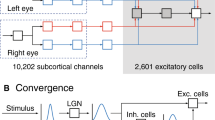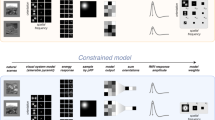Abstract
The orientation map is a hallmark of primary visual cortex in higher mammals. It is not yet known how orientation maps develop, what function they have in visual processing and why some species lack them. Here we advance the notion that quasi-periodic orientation maps are established by moiré interference of regularly spaced ON- and OFF-center retinal ganglion cell mosaics. A key prediction of the theory is that the centers of iso-orientation domains must be arranged in a hexagonal lattice on the cortical surface. Here we show that such a pattern is observed in individuals of four different species: monkeys, cats, tree shrews and ferrets. The proposed mechanism explains how orientation maps can develop without requiring precise patterns of spontaneous activity or molecular guidance. Further, it offers a possible account for the emergence of orientation tuning in single neurons despite the absence of orderly orientation maps in rodents species.
This is a preview of subscription content, access via your institution
Access options
Subscribe to this journal
Receive 12 print issues and online access
$209.00 per year
only $17.42 per issue
Buy this article
- Purchase on Springer Link
- Instant access to full article PDF
Prices may be subject to local taxes which are calculated during checkout





Similar content being viewed by others
References
Hubel, D.H. & Wiesel, T.N. Ferrier lecture. Functional architecture of macaque monkey visual cortex. Proc. R. Soc. Lond. B 198, 1–59 (1977).
Blasdel, G.G. & Salama, G. Voltage-sensitive dyes reveal a modular organization in monkey striate cortex. Nature 321, 579–585 (1986).
Ts'o, D.Y., Frostig, R.D., Lieke, E.E. & Grinvald, A. Functional organization of primate visual cortex revealed by high resolution optical imaging. Science 249, 417–420 (1990).
Obermayer, K. & Blasdel, G.G. Geometry of orientation and ocular dominance columns in monkey striate cortex. J. Neurosci. 13, 4114–4129 (1993).
Bonhoeffer, T. & Grinvald, A. The layout of iso-orientation domains in area-18 of cat visual-cortex—optical imaging reveals a pinwheel-like organization. J. Neurosci. 13, 4157–4180 (1993).
Bonhoeffer, T. & Grinvald, A. Iso-orientation domains in cat visual-cortex are arranged in pinwheel-like patterns. Nature 353, 429–431 (1991).
Purves, D., Riddle, D.R. & Lamantia, A.S. Iterated patterns of brain circuitry (or how the cortex gets its spots). Trends Neurosci. 15, 362–368 (1992).
Horton, J.C. & Adams, D.L. The cortical column: a structure without a function. Phil. Trans. R. Soc. B 360, 837–862 (2005).
Van Hooser, S.D. Similarity and diversity in visual cortex: is there a unifying theory of cortical computation? Neuroscientist 13, 639–656 (2007).
Ohki, K., Chung, S., Ch'ng, Y.H., Kara, P. & Reid, R.C. Functional imaging with cellular resolution reveals precise micro-architecture in visual cortex. Nature 433, 597–603 (2005).
Van Hooser, S.D., Heimel, J.A.F., Chung, S., Nelson, S.B. & Toth, L.J. Orientation selectivity without orientation maps in visual cortex of a highly visual mammal. J. Neurosci. 25, 19–28 (2005).
Adams, D.L. & Horton, J.C. Capricious expression of cortical columns in the primate brain. Nat. Neurosci. 6, 113–114 (2003).
Livingstone, M.S., Nori, S., Freeman, D.C. & Hubel, D.H. Stereopsis and binocularity in the squirrel-monkey. Vision Res. 35, 345–354 (1995).
Hubel, D.H. & Wiesel, T.N. Receptive fields of cells in striate cortex of very young, visually inexperienced kittens. J. Neurophysiol. 26, 994–1002 (1963).
Crair, M.C., Gillespie, D.C. & Stryker, M.P. The role of visual experience in the development of columns in cat visual cortex. Science 279, 566–570 (1998).
Chapman, B., Stryker, M.P. & Bonhoeffer, T. Development of orientation preference maps in ferret primary visual cortex. J. Neurosci. 16, 6443–6453 (1996).
Gödecke, I., Kim, D.S., Bonhoeffer, T. & Singer, W. Development of orientation preference maps in area 18 of kitten visual cortex. Eur. J. Neurosci. 9, 1754–1762 (1997).
White, L.E., Coppola, D.M. & Fitzpatrick, D. The contribution of sensory experience to the maturation of orientation selectivity in ferret visual cortex. Nature 411, 1049–1052 (2001).
Albus, K. & Wolf, W. Early post-natal development of neuronal function in the kitten's visual-cortex: a laminar analysis. J. Physiol. 348, 153–185 (1984).
Braastad, B.O. & Heggelund, P. Development of spatial receptive-field organization and orientation selectivity in kitten striate cortex. J. Neurophysiol. 53, 1158–1178 (1985).
Miller, K.D. Development of orientation columns via competition between on-center and off-center inputs. Neuroreport 3, 73–76 (1992).
Ohshiro, T. & Weliky, M. Simple fall-off pattern of correlated neural activity in the developing lateral geniculate nucleus. Nat. Neurosci. 9, 1541–1548 (2006).
Swindale, N.V. The development of topography in the visual cortex: a review of models. Network 7, 161–247 (1996).
Reid, R.C. & Alonso, J.M. Specificity of monosynaptic connections from thalamus to visual-cortex. Nature 378, 281–284 (1995).
Sherk, H. & Stryker, M.P. Quantitative study of cortical orientation selectivity in visually inexperienced kitten. J. Neurophysiol. 39, 63–70 (1976).
Ringach, D.L. Haphazard wiring of simple receptive fields and orientation columns in visual cortex. J. Neurophysiol. 92, 468–476 (2004).
Ringach, D.L. On the origin of the functional architecture of the cortex. PLoS ONE 2, e251 (2007).
Wässle, H., Boycott, B.B. & Illing, R-B. Morphology and mosaic of on-beta and off-beta cells in the cat retina and some functional considerations. Proc. R. Soc. Lond. B 212, 177–195 (1981).
Soodak, R.E. The retinal ganglion-cell mosaic defines orientation columns in striate cortex. Proc. Natl. Acad. Sci. USA 84, 3936–3940 (1987).
Amidror, I. The Theory of the Moiré Phenomenon (Kluwer Academic, Norwell, Massachusetts, USA, 2000).
Rockhill, R.L., Euler, T. & Masland, R.H. Spatial order within but not between types of retinal neurons. Proc. Natl. Acad. Sci. USA 97, 2303–2307 (2000).
Eglen, S.J., Diggle, P.J. & Troy, J.B. Homotypic constraints dominate positioning of on- and off-center beta retinal ganglion cells. Vis. Neurosci. 22, 859–871 (2005).
Gauthier, J.L. et al. Uniform signal redundancy of parasol and midget ganglion cells in primate retina. J. Neurosci. 29, 4675–4680 (2009).
Usrey, W.M., Reppas, J.B. & Reid, R.C. Specificity and strength of retinogeniculate connections. J. Neurophysiol. 82, 3527–3540 (1999).
Blair, H.T., Welday, A.C. & Zhang, K. Scale-invariant memory representations emerge from moiré interference between grid fields that produce theta oscillations: a computational model. J. Neurosci. 27, 3211–3229 (2007).
Miller, K.D. A model for the development of simple cell receptive-fields and the ordered arrangement of orientation columns through activity-dependent competition between ON- and OFF-center inputs. J. Neurosci. 14, 409–441 (1994).
Ringach, D.L. Spatial structure and symmetry of simple-cell receptive fields in macaque primary visual cortex. J. Neurophysiol. 88, 455–463 (2002).
Muir, D.R. et al. Embedding of cortical representations by the superficial patch system. Cerebral Cortex, 10.1093/cercor/bhq290 (7 March 2011).
Miller, K.D., Erwin, E. & Kayser, A. Is the development of orientation selectivity instructed by activity? J. Neurobiol. 41, 44–57 (1999).
Anishchenko, A. et al. Receptive field mosaics of retinal ganglion cells are established without visual experience. J. Neurophysiol. 103, 1856–1864 (2010).
Jin, J.Z. et al. On and off domains of geniculate afferents in cat primary visual cortex. Nat. Neurosci. 11, 88–94 (2008).
Jin, J., Wang, Y., Swadlow, H.A. & Alonso, J.M. Population receptive fields of ON and OFF thalamic inputs to an orientation column in visual cortex. Nat. Neurosci. 14, 232–238 (2011).
Tavazoie, S.F. & Reid, R.C. Diverse receptive fields in the lateral geniculate nucleus during thalamocortical development. Nat. Neurosci. 3, 608–616 (2000).
Smith, S.L. & Hausser, M. Parallel processing of visual space by neighboring neurons in mouse visual cortex. Nat. Neurosci. 13, 1144–1149 (2010).
Niell, C.M. & Stryker, M.P. Highly selective receptive fields in mouse visual cortex. J. Neurosci. 28, 7520–7536 (2008).
Vanduffel, W., Tootell, R.B.H., Schoups, A.A. & Orban, G.A. The organization of orientation selectivity throughout macaque visual cortex. Cereb. Cortex 12, 647–662 (2002).
Poggio, G.F., Baker, F.H., Mansfield, R.J., Sillito, A. & Grigg, P. Spatial and chromatic properties of neurons subserving foveal and parafoveal vision in rhesus monkey. Brain Res. 100, 25–59 (1975).
Das, A. & Gilbert, C.D. Distortions of visuotopic map match orientation singularities in primary visual cortex. Nature 387, 594–598 (1997).
Benucci, A., Ringach, D.L. & Carandini, M. Coding of stimulus sequences by population responses in visual cortex. Nat. Neurosci. 12, 1317–1324 (2009).
Blasdel, G.G. Orientation selectivity, preference, and continuity in monkey striate cortex. J. Neurosci. 12, 3139–3161 (1992).
Acknowledgements
We are grateful to A. Benucci and M. Carandini (University College London) for sharing their imaging data of cat primary visual cortex, supported by research grant EY017396 to M. Carandini. We also thank D. Fitzpatrick (Max Planck Florida Institute), L. White (Duke University), W. Bosking (University Texas at Austin) and Y. Li (UC Berkeley) for sharing existing ferret and tree shrew maps. We thank M. Carandini, D. Fitzpatrick, R. Shapley, J.-M. Alonso and E. Callaway for providing comments on earlier versions of this manuscript. This work was supported by research grant EY018322 (D.L.R.).
Author information
Authors and Affiliations
Contributions
Both S.-B.P. and D.L.R. were responsible for the theoretical concepts, computer simulations and writing.
Corresponding author
Ethics declarations
Competing interests
The authors declare no competing financial interests.
Supplementary information
Supplementary Text and Figures
Supplementary Figures 1–4 and Supplementary Discussion (PDF 1786 kb)
Rights and permissions
About this article
Cite this article
Paik, SB., Ringach, D. Retinal origin of orientation maps in visual cortex. Nat Neurosci 14, 919–925 (2011). https://doi.org/10.1038/nn.2824
Received:
Accepted:
Published:
Issue Date:
DOI: https://doi.org/10.1038/nn.2824
This article is cited by
-
NILRNN: A Neocortex-Inspired Locally Recurrent Neural Network for Unsupervised Feature Learning in Sequential Data
Cognitive Computation (2023)
-
A theory of cortical map formation in the visual brain
Nature Communications (2022)
-
ON/OFF domains shape receptive field structure in mouse visual cortex
Nature Communications (2022)
-
Natural scene sampling reveals reliable coarse-scale orientation tuning in human V1
Nature Communications (2022)
-
Mechanism underpinning the sharpening of orientation and spatial frequency selectivities in the tree shrew (Tupaia belangeri) primary visual cortex
Brain Structure and Function (2022)



